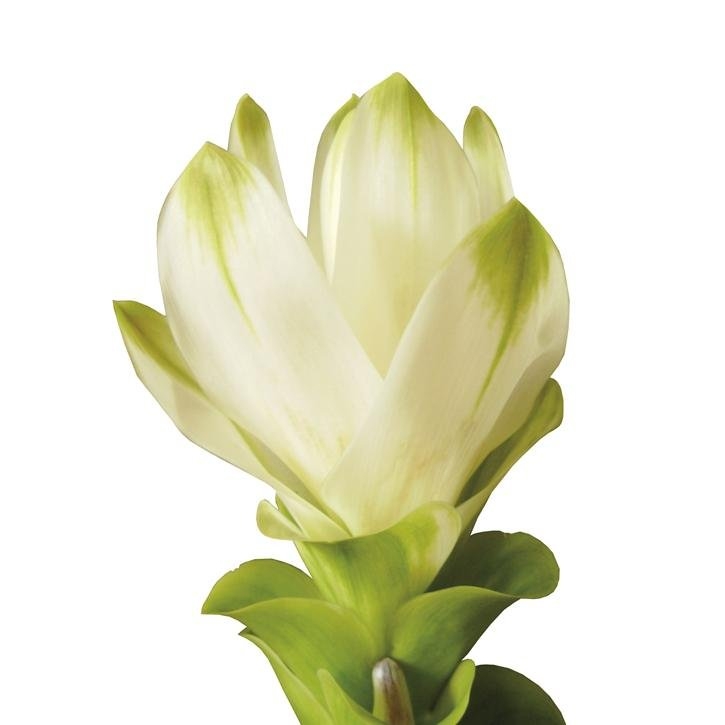Curcuma longa L.
Description
It is a plant of the Zingiberaceae family native to Southeast Asia. It is known worldwide as an aromatic spice, used in Asian cuisine to give a touch of color and spicy flavor to dishes.
It is a perennial herbaceous plant about 2 meters high. It has long, lanceolate and petiolate leaves of a uniform green color. Turmeric is a sterile triploid that rarely flowers, but when it does, its flowers are dull yellow with a tendency to white, gathered in bracts of 3 to 5 flowers; the inflorescence is pink, being more intense in the upper terminal part. The roots or tubers are oblongopalmate, wrinkled on the outside, brown on the outside and deep orange inside. It is this rhizome that makes turmeric a really interesting plant from a gastronomic, medicinal, food and cosmetic point of view. There is no seed formation and therefore the plant reproduces vegetatively by cuttings from the rhizome.
Part used
The rhizome is used.
Active principles
- Curcuminoids (3-5%): curcumin (the majority and most important), monodesmetoxicurcumin and bisdesmetoxicurcumin are also found. They are the compounds responsible for the yellow-orange color of the plant.
- Essential oil (20-70 mg/kg), rich in terpenic carbides (zingiberene, β- and δ-curcumene, α-curcumene) and sesquiterpenic ketones (turmerones). The essential oil imparts the characteristic odor to this root.
- Polysaccharides (40-45%) mainly arabinogalactans (ukonanas A and C).
- Minerals (3-5%): calcium, iron, magnesium, phosphorus, potassium, sodium and zinc.
- Vitamins: C, B1, B2, B3, B6, folate, α-tocopherol, K.
- Others: carotenes, and water soluble peptides.
Pharmacological action
- Anti-inflammatory (both in acute and chronic inflammation). Curcumin has been shown to inhibit the enzymes 2-cyclooxygenase, 5-lipooxygenase and inducible nitric oxide synthase (iNOS), prevent the activation of certain transcription factors and decrease the concentration of proinflammatory cytokines (TNF-α, IL-1, IL-2, IL-6, IL-8, IL-12) and chemotactic factors.
- Hepatoprotective: in vivo and in vitro, against the cytotoxic action of carbon tetrachloride, which seems to be due to the presence of curcumin.
- Antiulcerous and cytoprotective. Inhibits the growth of Helicobacter pylori.
- Choleretic and cholagogue.
- Appetite stimulant.
- Antioxidant and anti-inflammatory.
- Antibacterial, antiviral and antifungal.
- Effects on glycemia: some studies show that after the administration of turmeric, postprandial insulin concentration increases, suggesting that this plant produces some effect on insulin secretion. In addition, turmeric improves insulin sensitivity through a mechanism mediated by PPARγ receptors.
- Action on the CNS: curcumin has demonstrated neuroprotective, anticonvulsant, antidepressant, anti-stress and anxiolytic activity. Proposed mechanisms of action include selective inhibition of the enzyme iNOS (inducible nitric oxide synthase).
- Anticancer: against different cell lines, especially in processes related to the digestive system. On cholangiocarcinoma, biliary cell cancer, curcumin inhibited cell proliferation and induced apoptosis of these cells through different mechanisms, such as inhibition of nuclear factor (NF)-κB activation or induction of peroxisome proliferator-activated receptor gamma (PPR-γ) expression. It also prevented the proliferation of colon cancer cells.
Indications
- Osteoarthritis, rheumatic diseases: to relieve pain and inflammation.
- Slow and heavy digestions, with sensation of fullness, meteorism.
- Peptic ulcer, gastritis.
- Premenstrual syndrome, dysmenorrhea.
- Neuropathic pain: sciatica, diabetic or alcoholic neuropathy, neuroinflammation induced by chemotherapy, spinal cord injuries.
- Other indications: adjuvant in the treatment of diabetes, hyperlipidemia, metabolic syndrome, hepatopathies, cancer, depression, Parkinson's disease, cognitive impairment.
Contraindications
- Pregnancy and lactation.
- Obstruction of bile ducts, cholangitis, stones and other biliary alterations.
- Situations with risk of bleeding, such as: coagulation disorders, or upcoming or recent surgeries.
Precautions
- Diabetes.
- In susceptible persons, it may increase the risk of renal lithiasis.
Drug interactions
- Oral anticoagulants.
- Although no interaction has been described, due to its hypoglycemic effect, turmeric could potentiate the effect of hypoglycemic drugs.
Side effects
- Dry mouth.
- Flatulence.
- Gastric irritation.
Bibliography
Jurenka JS. Anti-inflammatory properties of curcumin, a major constituent of Curcuma longa: a review of preclinical and clinical research. Altern Med Rev 2009; 14: 141-153
Daily JW, Yang M, Park S. Efficacy of turmeric extracts and curcumin for alleviating the symptoms of joint arthritis: a systematic review and meta-analysis of randomized clinical trials. J Med Food. 2016; 19 (8): 717-29.
Liu X, Machado GC, Eyles JP, Ravi V, Hunter DJ. Dietary supplements for treating osteoarthritis: a systematic review and meta-analysis. Br J Sports Med. 2018; 52 (3): 167-175
Henrotin Y, Malaise M, Wittoek R, de Vlam K, Brasseur JP, Luyten FP, et al. Bio-optimized Curcuma longa extract is efficient on knee osteoarthritis pain: a double-blind multicenter randomized placebo controlled three-arm study. Arthritis Res Ther. 2019; 21 (1): 179.
Pinsornsak P, Niempoog S. The efficacy of Curcuma Longa L. extract as an adjuvant therapy in primary knee osteoarthritis: a randomized control trial. J Med Assoc Thai. 2012; 95 Suppl 1: S51-8.
Jamwal R. Bioavailable curcumin formulations: A review of pharmacokinetic studies in healthy volunteers. J Integr Med. 2018 Jul 4. pii: S2095-4964(18)30077-3.
Khayat S, Fanaei H, Kheirkhah M, Moghadam ZB, Kasaeian A, Javadimehr M. Curcumin attenuates severity of premenstrual syndrome symptoms: A randomized, double-blind, placebo-controlled trial. Complement Ther Med. 2015; 23 (3): 318-24.
Wickenberg J, Ingemansson SL, Hlebowicz J. Effects of Curcuma longa (turmeric) on postprandial plasma glucose and insulin in healthy subjects. Nutr J 2010; 9: 43.
